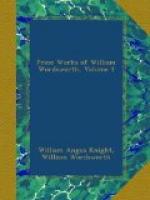500. *_Address to the Scholars of the Village School_.
Were composed at Goslar in Germany. They will
be placed among the
Elegiac pieces.
501. *_Elegiac Stanzas suggested by a Picture of Peel Castle_. [VI.]
Sir George Beaumont painted two pictures of this subject, one of which he gave to Mrs. Wordsworth, saying she ought to have it: but Lady B. interfered, and after Sir George’s death she gave it to Sir Uvedale Price, in whose house at Foxley I have seen it—rather grudgingly I own.
502. Elegiac Verses. [VIII.]
In memory of my Brother, John Wordsworth, Commander of the E.I. Company’s ship the Earl of Abergavenny, in which he perished by calamitous shipwreck, Feb. 6, 1805. Composed near the Mountain track that leads from Grasmere through Grisdale Hawes, where it descends towards Patterdale. 1805.
503. Moss Campion (Silene acaulis). [Ibid. II. l. 5.]
This most beautiful plant is scarce in England, though it is found in great abundance upon the mountains of Scotland. The first specimen I ever saw of it, in its native bed, was singularly fine, the tuft or cushion being at least eight inches in diameter, and the root proportionably thick. I have only met with it in two places among our mountains, in both of which I have since sought for it in vain.
Botanists will not, I hope, take it ill, if I caution them against carrying off, inconsiderately, rare and beautiful plants. This has often been done, particularly from Ingleborough and other mountains in Yorkshire, till the species have totally disappeared, to the great regret of lovers of Nature living near the places where they grew.
504. Lines.
Composed at Grasmere, during a walk one evening after a stormy day, the Author having just read in a newspaper that the dissolution of Mr. Fox was hourly expected, ‘Loud is the Vale,’ &c. [IX.]
505. *_Invocation to the Earth_. [x.]
Composed immediately after the Thanksgiving Ode, to which it may be considered as a second part.
506. *_Elegiac Stanzas. Addressed to Sir G.H.B_. [XII.]
On Mrs. Fermor. This lady had been a widow long before I knew her. Her husband was of the family of the lady celebrated in the ’Rape of the Lock,’ and was, I believe, a Roman Catholic. The sorrow which his death caused her was fearful in its character, as described in this Poem, but was subdued in course of time by the strength of her religious faith. I have been for many weeks at a time an inmate with her at Coleorton Hall, as were also Mary and my sister. The truth in the sketch of her character here given was acknowledged with gratitude by her nearest relatives. She was eloquent in conversation, energetic upon public matters, open in respect to these, but slow to communicate her personal feelings. Upon these she never touched in her intercourse with me, so that I could not regard myself as her confidential friend, and was accordingly surprised when I learnt she had left me a legacy of 100_l._ as a token of her esteem. See in further illustration, the second stanza inscribed upon her cenotaph in Coleorton Church.




